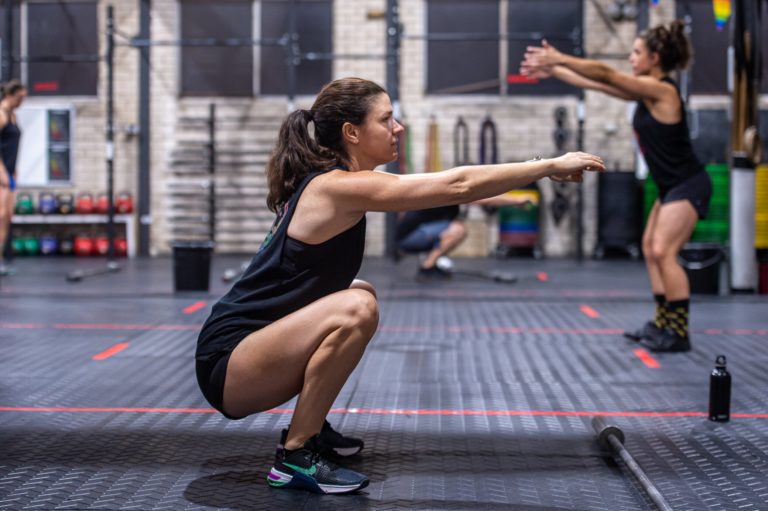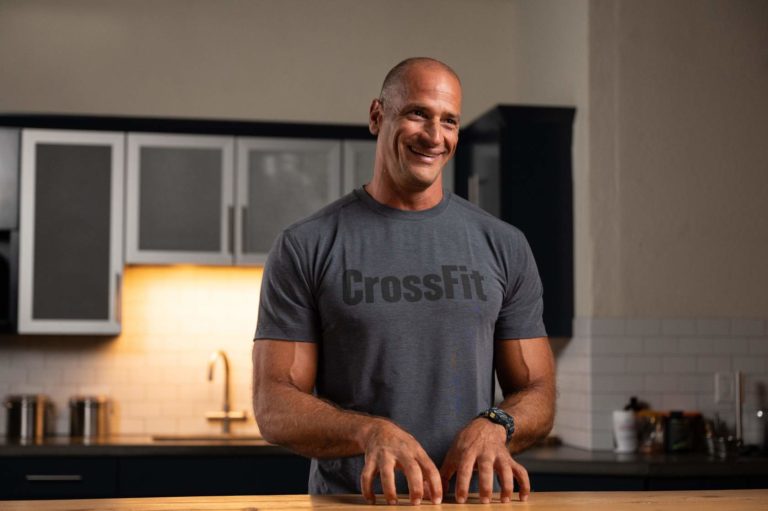The squat is essential to your well-being. Squatting develops mobility around your ankles, knees, and hips, keeping these joints healthy and functioning for a lifetime. If you have knee, hip, or lower back pain, you must squat more, not less, and always with excellent technique.
 Squats are a fundamental movement pattern you use daily whether you have the capacity or not. A squat is required when you get on and off a chair, get in and out of the car, get on and off the toilet, and get down and back up off the ground. Regarding your athleticism, your squat impacts your capacity to extend your hips, which is critical for running fast, jumping high, and throwing and punching hard. Squatting is an essential part of CrossFit.
Squats are a fundamental movement pattern you use daily whether you have the capacity or not. A squat is required when you get on and off a chair, get in and out of the car, get on and off the toilet, and get down and back up off the ground. Regarding your athleticism, your squat impacts your capacity to extend your hips, which is critical for running fast, jumping high, and throwing and punching hard. Squatting is an essential part of CrossFit.
Out of all the squat variations used in CrossFit, no movement is more foundational than the air squat. For most people joining CrossFit, the first experience is learning to air squat. We believe if you can’t squat correctly, you are functioning at a fraction of your capacity and are limiting your ability to live independently. The more difficulty you have performing this movement, the more we insist you continue to practice and refine it, as your difficulty exactly describes your need to squat.
Technique
Proper technique is essential to achieve all the listed benefits of squatting. Fortunately, learning to squat safely is relatively easy. A proper squat looks like this:
- Start with your heels at approximately shoulder width and your toes turned out slightly. This foot position works well for most athletes, but you can alter it as needed based on your success in executing a squat. Ultimately, the foot position that allows you to perform your best squat is the one you should use.
- In the top position, your legs and hips should be fully extended to their natural end range of motion. Keep your spine neutral by engaging your abdominals and looking straight ahead.
- To initiate the movement, push your hips back and down until the crease of your hips is lower than the tops of your knees. This is the bottom position. From here, drive through your heels, squeeze your glutes and hamstrings, and return to the start position.
- Throughout the movement, maintain your lumbar curve, keep pressure on your heels, and ensure your knees track your toes.
To help you learn, refine, and master the air squat, the CrossFit Journal article “Squat Clinic” is indispensable. Read over the common faults in the squat. If you have any of these, practice the corrective drills listed. Another great teaching method for the squat taught at the CrossFit Level 1 Certificate Course is Squat Therapy.
Squat Therapy is a diagnostic and corrective tool for any athlete, regardless of capacity or skill, looking to refine any part of their squat. The drill goes like this:
- The athlete sets up facing a wall with a medicine ball placed behind them as a depth target. The athlete should be close enough to the wall that it will be challenging for them to keep from touching it as they descend, but not so close they have no room to descend. Similarly, the bottom position should be slightly challenging to achieve, but not so much that technique is sacrificed to reach the ball.
- The athlete performs a slow, controlled rep, and their musculature is engaged to maintain proper form. At any point along the rep, if technique deteriorates, the coach pauses the athlete, fixes the issue, and the rep continues toward the bottom target. If the problem cannot be fixed, the setup is too challenging for the athlete, and they need to back away from the wall slightly or raise the bottom position.
- Once sound mechanics are comfortably maintained with the current set-up, the coach nudges the athlete closer to the wall, lowers the bottom target slightly, and repeats the process. The coach must always remain vigilant for faults, such as the knees caving in or the athlete collapsing in the bottom position, that will creep in as the athlete gets challenged more and more.
- Moving closer to the wall and reducing the target’s height continues until the athlete’s mechanics break down, or they demonstrate all of the technique elements required while standing very close to the wall and squatting to the proper depth. Over time, Squat Therapy will help an athlete develop a virtuous squat.
As the ability to do air squats increases, do not rush training the front, back, and overhead squats. Any small, seemingly insignificant fault in the air squat will be dramatically magnified in the weighted versions. If you possess any degree of the most common faults: surrendering the lumbar curve at the bottom, not breaking parallel with the thighs in the bottom position, dropping the chest on the descent, or lifting the heels, it’s too early to move on to weighted squats. Master your air squat first.
Even once you have moved on to training weighted squats, do not relegate the air squat to a quick warm-up set or the met-con. Dedicated, deliberate air squat practice such as Squat Therapy is required weekly, if not several times a week, to continually develop capacity and improve this infinitely refinable movement pattern. Mastery in the air squat will serve you well with all your fitness and health goals throughout your life, so make sure to put your time in.
About the Author
 Stephane Rochet is a Senior Content Writer for CrossFit. He has worked as a Flowmaster on the CrossFit Seminar Staff and has over 15 years of experience as a collegiate/tactical strength and conditioning coach. He is a Certified CrossFit Trainer (CF-L3) and enjoys training athletes in his garage gym.
Stephane Rochet is a Senior Content Writer for CrossFit. He has worked as a Flowmaster on the CrossFit Seminar Staff and has over 15 years of experience as a collegiate/tactical strength and conditioning coach. He is a Certified CrossFit Trainer (CF-L3) and enjoys training athletes in his garage gym.
The Essential Air Squat